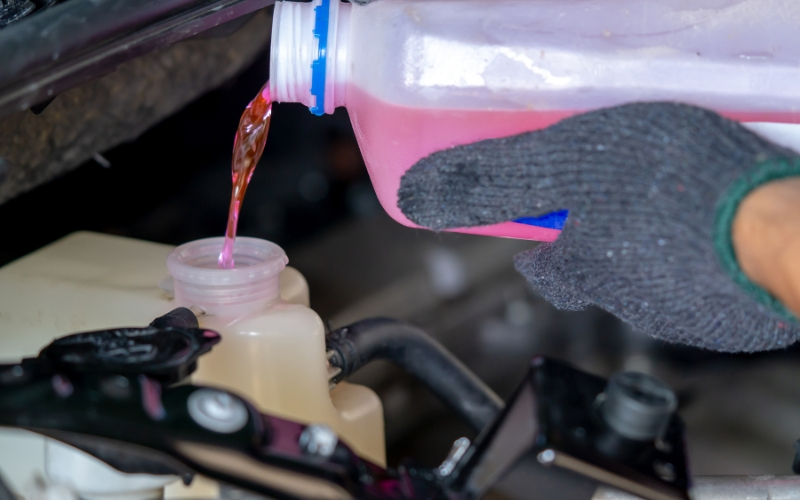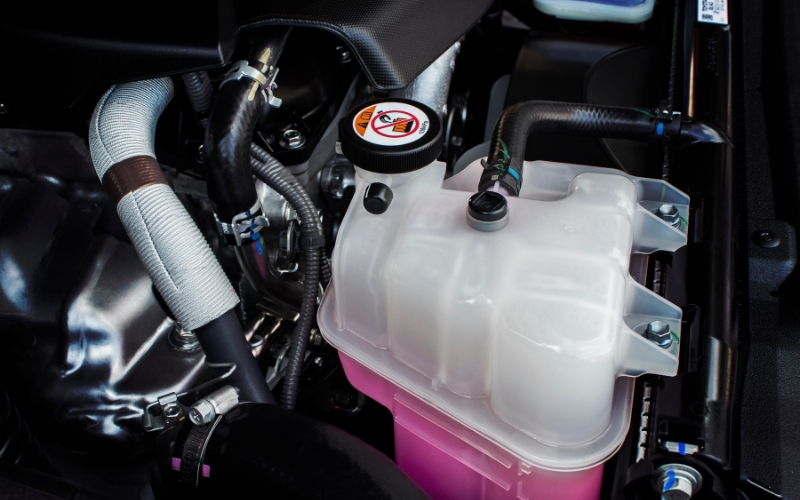How to Add Antifreeze to Your Car
30 Jan 2025

Antifreeze is an important fluid that helps to keep your car’s engine in the right temperature range whilst running. Ensuring that your car has enough of the right antifreeze can help protect the engine and keep your car running optimally at all times of the year.
Is antifreeze the same as coolant?
Antifreeze and coolant are not quite the same thing, but they are similar and often the name is used interchangeably.
- Antifreeze is a concentrated chemical, usually made of ethylene glycol or propylene glycol, that needs to be diluted with water before use. Its primary function is to prevent freezing and overheating in your car’s engine cooling system.
- Coolant is the ready-to-use mixture of antifreeze and water (typically a 50:50 ratio) that circulates through your car’s cooling system. It’s often sold pre-mixed for convenience.
Key takeaway: Antifreeze is a component of coolant. If you’re using antifreeze directly, it often needs to be diluted with water before adding it to your car’s cooling system.
Why is antifreeze essential all year round?
The term antifreeze can give the impression that this is a fluid your car only needs during the winter or in extreme cold temperatures. However, it’s something that is vitally important to the health and safe running of your engine at all times of the year and is essential to the cooling system of cars.
- Antifreeze prevents engine fluid from freezing
Antifreeze ensures that the fluid in your engine won’t freeze in cold weather, which can cause severe damage such as cracked engine blocks or burst hoses. - Prevents your engine from overheating
With a boiling point higher than water, antifreeze helps prevent the engine from overheating during hot weather or prolonged driving. - Protects against corrosion
Antifreeze contains inhibitors that prevent rust and corrosion inside your car’s cooling system, extending the life of the radiator, hoses and other components.
To summarise, antifreeze is critical in colder weather where freezing temperatures can cause engine fluids to solidify. If you live in a region with harsh winters, always make sure your antifreeze levels are topped up before the cold season begins.
That being said, many drivers overlook antifreeze in the summer, but it’s equally important during hot weather. Antifreeze helps disperse heat, keeping your engine cool even on long road trips or in stop-and-go traffic.
If your coolant system shows signs of rust, discoloration, or frequent leaks, using a high-quality antifreeze can restore proper function and protect against further damage.
How to choose the right antifreeze
Antifreeze comes in various types and it’s important to know which type of antifreeze is the right one for your vehicle:
TOP TIP: Check your car’s manual. You should always use the type of antifreeze recommended by your vehicle’s manufacturer.
Types of antifreeze
Inorganic Acid Technology (IAT): Common in older vehicles. Typically green and requires more frequent replacement.
Organic Acid Technology (OAT): Found in newer vehicles. Usually orange or red, offering longer-lasting protection.
Hybrid Organic Acid Technology (HOAT): A mix of IAT and OAT, often yellow or turquoise, with extended service life.
Pre-Mixed vs. Concentrated
- Pre-mixed antifreeze is ready to use.
- Concentrated antifreeze needs to be diluted with water (usually a 50:50 ratio) before use.
Telling signs your antifreeze level is low
If you’re not entirely sure what the warning signs for low antifreeze levels are, keep an eye out for the following warning signs:
- Your dashboard warning light comes on
Many newer cars have a coolant warning light on the dashboard that will come on if it detects that the coolant levels are too low. This shouldn’t be confused with the cold engine light that some cars display on the dashboard when you first start them up and then will go off when the engine has warmed up.
The cold engine light is usually blue in colour, and this is nothing to worry about if it disappears after a few minutes of driving. If the blue light stays on for noticeably longer, you should check your antifreeze level.
The same symbol might be displayed as yellow in some cars, which usually means the coolant level is too low and more should be added as soon as possible.
If the dashboard warning light shows in red, it’s a sign the engine is overheating and you should stop driving straight away and arrange for a mechanic to check over the car.
- Your engine is overheating
Are your car’s temperature gauges rising? This can signal insufficient antifreeze. In the worst case scenario, steam may appear from your bonnet if your engine is running too hot. If this happens, it could be linked with other underlying issues, so you should get your car checked by a qualified mechanic.
TOP TIP: Remember not to touch your bonnet when the engine is hot.
- Your coolant is discoloured
Coolant should be bright (whether that’s bright green, red, yellow or blue). If your coolant is brown, rusty, or clear, it’s time to replace it.
- You’re frequently topping-up your coolant
If you’re constantly refilling your coolant, there may be a leak in your system that needs professional inspection.
How to add antifreeze to your car
To add more antifreeze/coolant, you’ll need:
- A cloth/rag
- Gloves
- Eye protection
- Funnel (optional)
A bottle of high-quality and appropriate coolant for your car OR a diluted mixture of antifreeze and water, as per the product instructions.

Ok, so all the signs are saying that you need to add antifreeze to your car. Once your engine has cooled, follow these steps to safely add antifreeze to your car:
- Make sure you’re prepared
Wear eye protection and gloves to protect yourself from spills or splashes. Use a cloth to slowly turn the coolant reservoir cap anti-clockwise. If you hear hissing or suction noises, pause and wait for the pressure to release before fully removing the cap.
- Add the antifreeze to the coolant reservoir
- If you are using concentrated antifreeze, mix it with water according to the product instructions (usually a 50:50 ratio) before adding it to the reservoir.
- Pour the antifreeze carefully into the reservoir, using a funnel if needed and make sure you do not exceed the maximum fill line.
- Replace the cap and start the engine
Secure the reservoir cap tightly to create a proper seal. Then, close the bonnet and start the engine - allow it to run for a few minutes to circulate the antifreeze.
- Check for warning lights
If the dashboard does not display a coolant warning light, your system should be good to go.
If your coolant warning light comes back on when driving, you should seek advice from a qualified mechanic.
Antifreeze is an essential fluid to help your engine run as it should, so it’s important to check the levels regularly and top it up if required. By following our guide, you can safely and quickly check your antifreeze/coolant reservoir and add more if needed.
Find out more about high-performance antifreeze and how it provides long-lasting protection for your car.

